Bart and I like to try local food when we visit a place. Every time we’ve visited Spain, we have enjoyed eating tapas. Buoyed by our Paella Making in Valencia, we decided that on this visit to Barcelona, we’d try out a cooking class in tapas making. After searching on Trip Advisor, we came across a few options.
In the end, we opted for the Classic Tapas Class with Barcelona Cooking. The class had the option of including a tour of the fantastic La Boqueria market. The class cost €65 or €78 if you wanted to include the market tour. We decided we’d take the tour.
The class was at 6 on a Saturday, with the tour starting an hour before that. We decided that making (and possibly more importantly, eating) tapas would be a fun way to spend a Saturday evening. So, we were all set for an evening of shopping and chefing.
Off to the fish farm
We made our way along Las Ramblas to find the cooking school. Normally when we walk down Las Ramblas, we aren’t on a timetable. As we were battling our way through the crowds I was struck by how long it takes to navigate through a throng of tourists. We eventually scraped through the door of the cooking school at 1 minute past 5. I was getting a bit on agitated by the idea of being late. I needn’t have worried as half the class still hadn’t arrived. It seems that many of our group were working on Spanish time.
My first thought when I saw the number of people in the class was that it was going to a bit crowded in the kitchen. However, once everyone had arrived we were split into two groups, each with their own chef. It turned out that Barcelona Cooking has two kitchens and can run two tapas making classes at the same time. Our chef, Stefano, turned out to be Italian, which was a bit of a surprise. In the end though, it turned out that he had trained in Food and Nutrition in Barcelona, making him well qualified to teach us about tapas.
Stefano rounded up our group and we headed back up Las Ramblas to El Mercat de Sant Josep de la Boqueria. When we arrived at the market Stefano told a bit about the history of the market. Better known as simply La Boqueria, the first records of a market date back to 1217. No one is certain where the name La Boqueria originates. One theory is that there was a fish farm close to the site and the name comes from bacallà, the Catalan word for cod.
Exploring La Boqueria
The market is always jammed full of tourists when we visit. However, going around there after 5 pm, the market seemed a bit quieter. We started our visit at the main gates, Stefano told us about the development of the market and its current status. La Boqueria is number 3 on Conde Nast Traveller’s list of the world’s best markets. When you walk around, it’s easy to see why.
As you walk through the ornate wrought-iron gates, you are immediately confronted by a host of fruit and vegetable stalls. These sell loads of different pots of cut fresh fruits to snack on. Along with these, they sell fantastic combinations of blended fruit drinks. However, our tip is to walk past these and head to the second and third rows of stalls. You’ll find the same drinks, but these stalls are €1 to €1.50 cheaper than the stalls at the front of the market.
The front of the market is predominantly fruit and veg, the meat stalls mainly to the back and the fish stalls are in a circle in the middle. Dotted around the market are delicatessens, charcuterie stalls and merchants of spices and dried goods. There are also stalls serving tapas and drinks. We’ve never eaten at these, but judging by the number of locals that eat there and the queues for seats, they must be good.
Our guide took us to various stalls to pick up some of the ingredients for our food. (The bulk of the shopping had been done earlier in the day). As we went around he explained about the different products. This included a lesson on the different types of Spanish ham and a bit of ham tasting. Knowing now how Iberico ham is produced, I can see why it’s so expensive.
Back to the kitchen for tapas making
Our tour of the market drew to a close and we made our way back to the school and up to the kitchen to start our tapas making class. The kitchen had a huge table, set up ready for us to prepare our food. The great thing was that we overlooked Las Ramblas, giving us a fantastic view of the people and stalls in the street below.
We were joined by a few more people who had decided not to take the tour of the market. With freshly washed hands and wearing our Barcelona Cooking aprons, we stood around as Stefano ran through the dishes we were going to make. He then went through each dish explaining what we needed to do to make them, along with guidance on knife skills and safe cutting.
After Stefano’s demo, we split up into groups of two & three to prepare the dishes. The dishes we made were Gazpacho de Fresas (Strawberry Gazpacho), Patatas Bravas, Albóndigas Mar y Montaña (Surf and Turf Meatballs) and Pintxo de Sobrasada (Spicy sausage pintxos). The four dishes represented tapas from different parts of Spain.
Bart and I decided to do the prep for the Gazpacho. This looked like a reasonably easy option. However, the action of grating the tomatoes soon began to make my wrists ache. (It takes a big stack of tomatoes to make gazpacho for 12 people). Before too long, I’d worked my way through the pile of tomatoes and Bart had chopped all the strawberries.
The group chatted as we worked and from being a bunch of strangers at the start of the session it soon felt like we were a group of friends. We blended our ingredients for the gazpacho and after seasoning, we put it in the freezer to chill.
Let the cooking commence…
We gave some of the others a hand to finish their prep and then we cleared the table and set it up to ready to eat. Now that the knives were out of the way, Stefano brought out the wine and for the rest of the session, the wine flowed freely.
As the bread for the pintxos toasted, one of us heated the Sobrasada while someone else made caramelised pears. The potatoes were cooked, another member of the group cooked the brava sauce and anther made aioli. Stefano produced a huge pan and filled it with oil. When it was hot, one of the group and I fried our meatballs. All the while we were chatting and helping one another out. After we’d finished frying the meatballs, another couple of us made the sauce for them.
Before we knew it, the food was ready and it was time to eat what we had made. We plated everything up and set everything down on the table.
The proof of the tapas making is in the eating
So how had it all turned out? Well, we started with the gazpacho. I’d wondered if it was going to a bit sweet with strawberries in. I needn’t have worried as the generous Spanish pinches of salt that we’d added, along with a bit of sherry vinegar, had balanced the sweetness nicely. For the two of us, it was the first time we’d tried gazpacho and it was a pleasant surprise how light and refreshing it was.
Moving on to the pintxos we were really pleased with the taste. The sweetness of the caramelised pear was perfect with the spicy Sobrasada sausage and the crumbs of blue goat’s cheese on the top gave them a beautiful texture when you chewed them. The Patatas Bravas had to be the most elegant ones I’ve ever seen. The Salsa Brava was way better than most of the ones I’ve tasted in restaurants.
The final dish was the Albóndigas. I was a bit sceptical about the sauce for the meatballs. I wasn’t at all sure about the cuttlefish and how it would work with the meat. Well, as it turned out, the cuttlefish in the sauce worked extremely well with the meatballs. All in all, it was a great meal.
The Spanish art of sitting and chatting
After we finished the food, no one seemed to be in a rush to leave. As we drank more wine, the group sat around the table and chatted. The Spanish have a word for this type of conversation, where a group sit and chat around the table after lunch or dinner. It’s called sobremesa, literally “around the table”. After a good meal, the sobremesa can last for hours, but for us, by 10:00 pm we were all talked out.
Slowly people started to leave and we were just about the last. One of the women in the group was chatting with the two of us and Stefano on the way out. She said she had been really surprised about how much work could go into making tapas. With my experience of working in kitchens, it was no surprise to me. I know too well that for food to come out of a kitchen quickly, a lot of prep has been done before you order it.
We wandered back to our apartment feeling happy and content. We’d made our tapas and we had enjoyed eating the food we’d made. We’d learnt about different tapas from different parts of Spain. It was a fun evening and great way to learn more about Spanish food and culture. If you visit Barcelona, taking the Classic Tapas Class with Barcelona Cooking is a great experience.
In Spanish culture, food is more than just about fuelling the body. Food is at the very heart of many social events and eating isn’t just about shovelling it down and moving on. A meal with family or friends is an event to be enjoyed. Taking the tapas making class was also a lesson in the Spanish way of enjoying food.




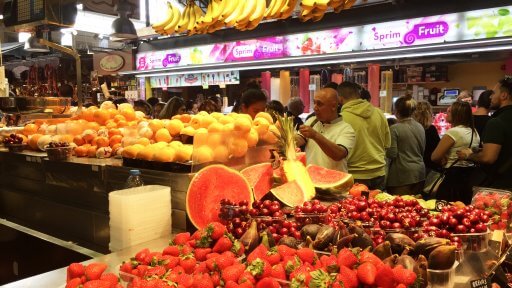
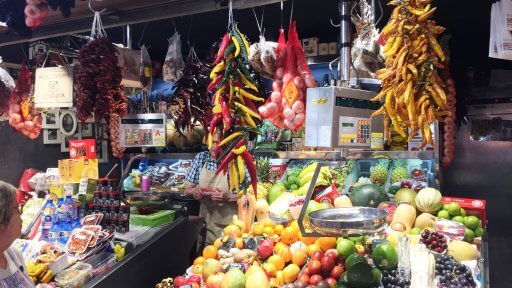

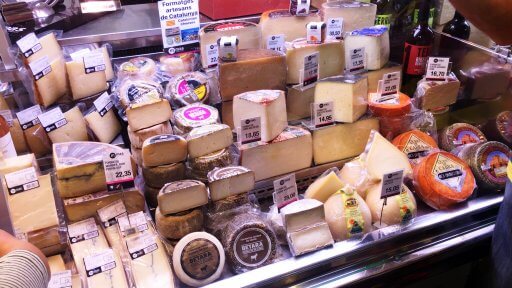
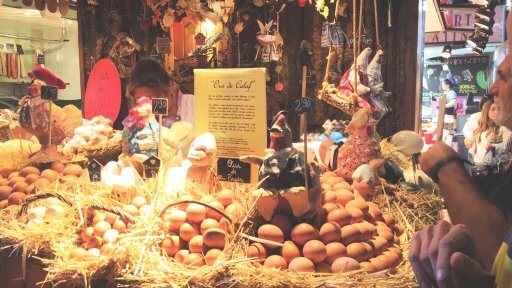
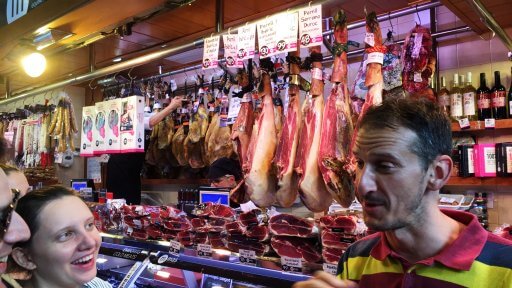
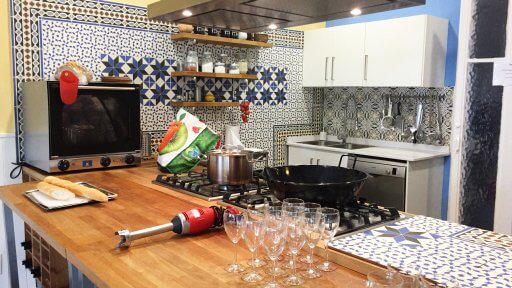
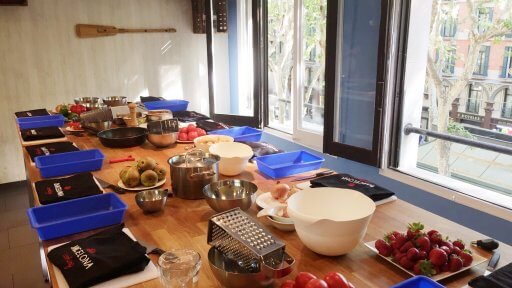
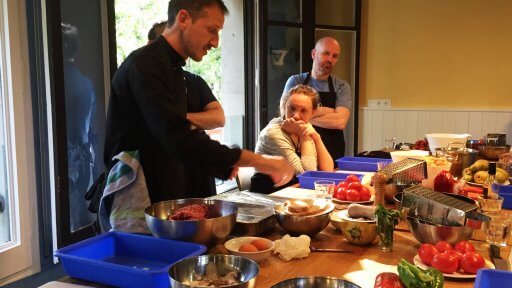
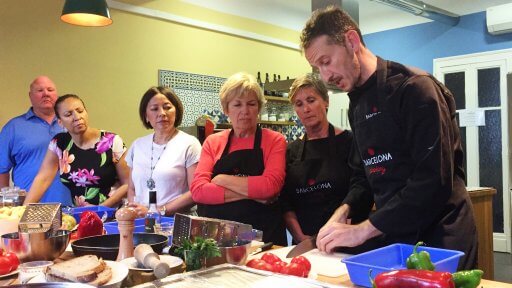
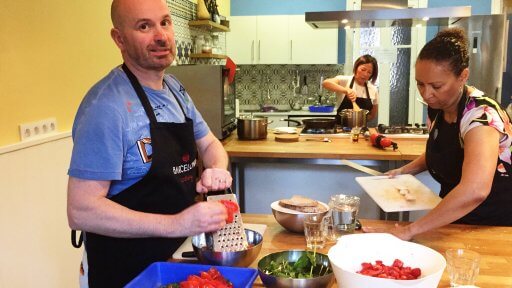
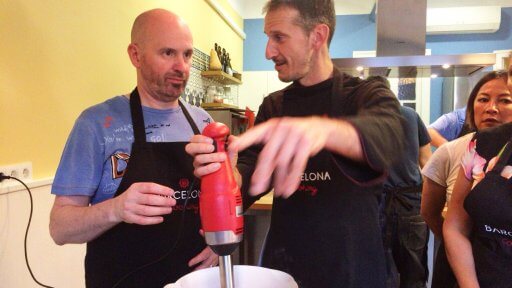
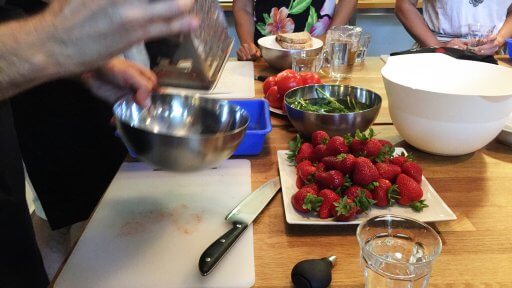
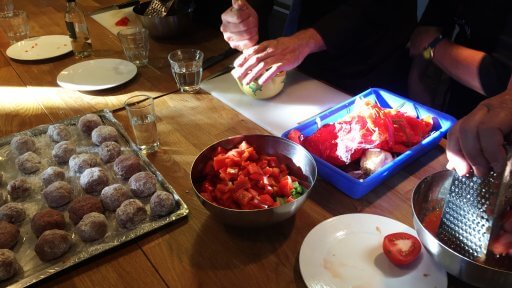
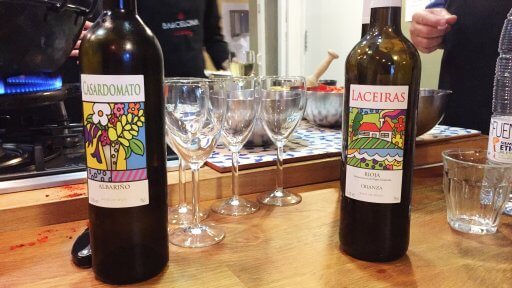
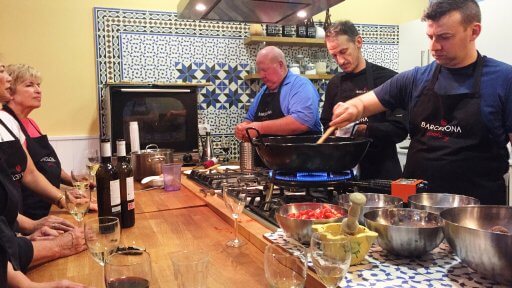
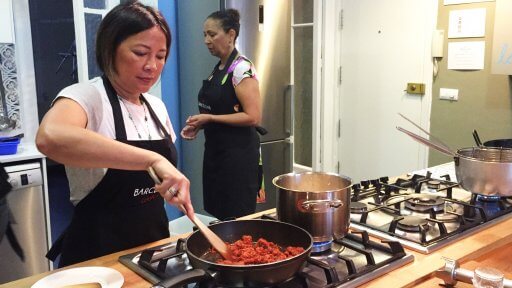
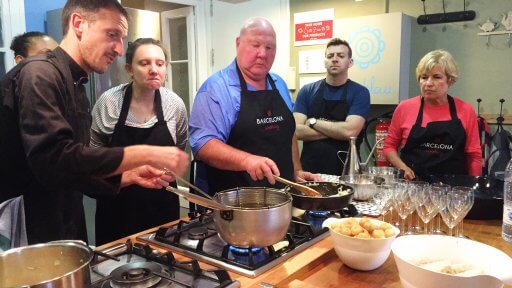
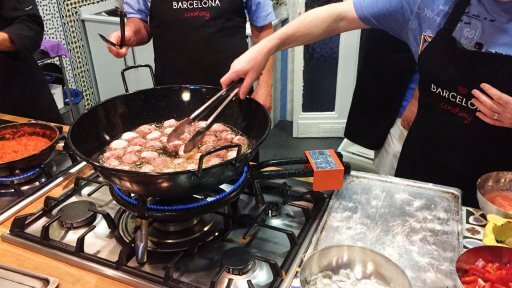
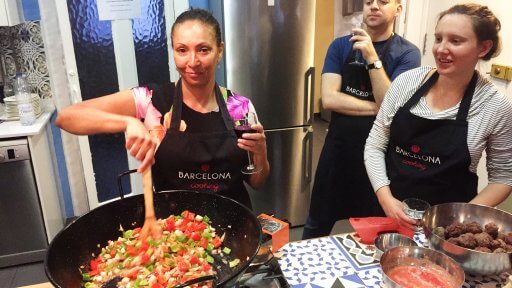
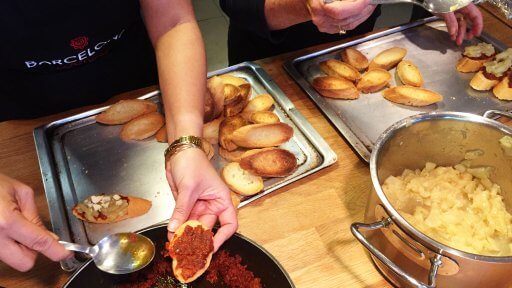
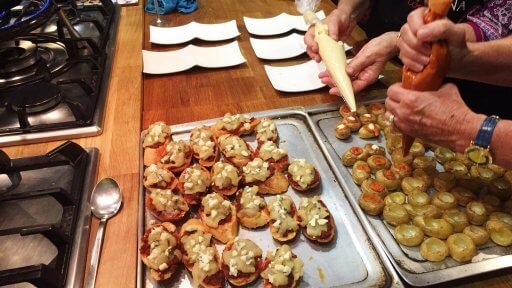

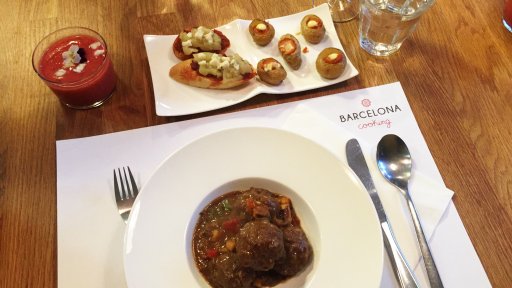

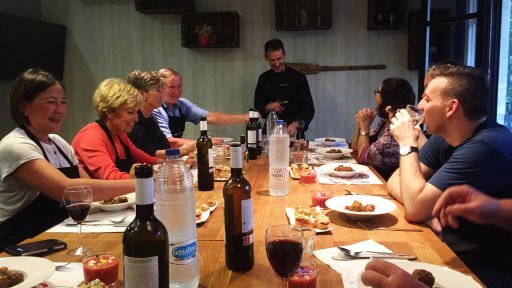
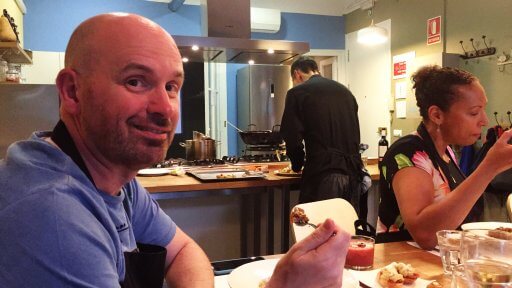

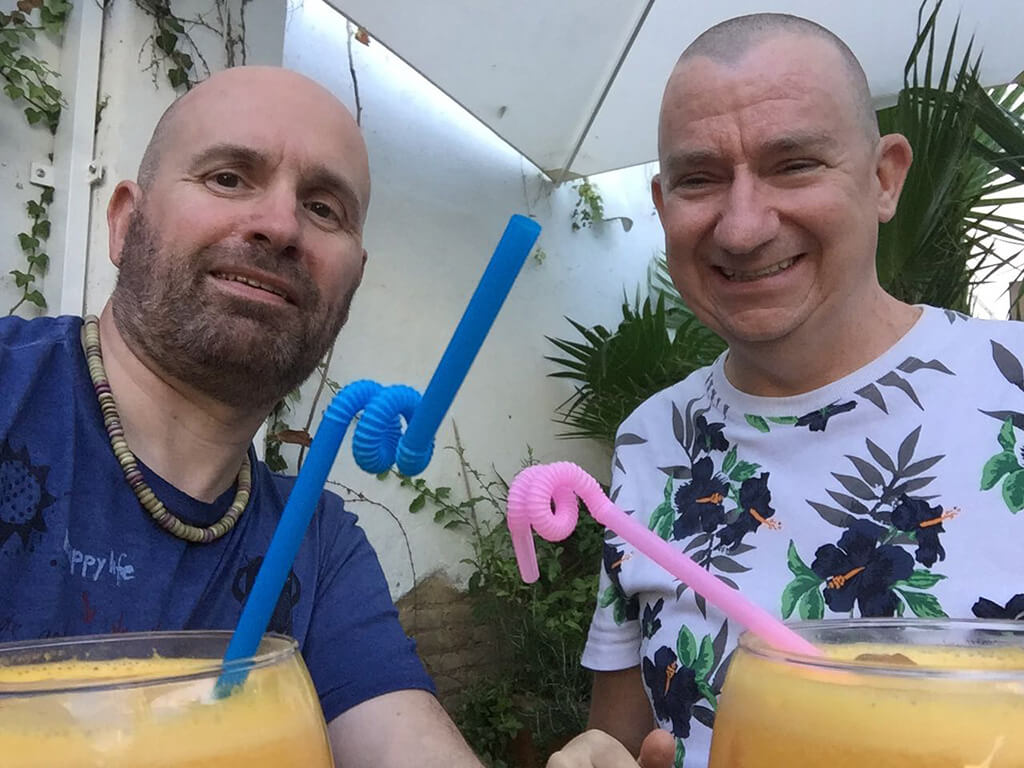

Ok, this is ridiculously cool! What an amazing experience!
Thanks Brooke, we’re so glad you enjoyed the article. Doing the tapas class was a great way of getting an insight into Spanish life, while having lots of fun and enjoying some great food too. We’ve really enjoyed doing our cooking experiences and we’re planning on doing more as we travel.